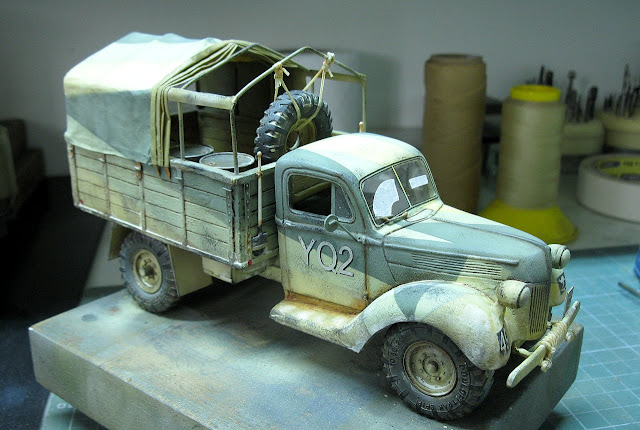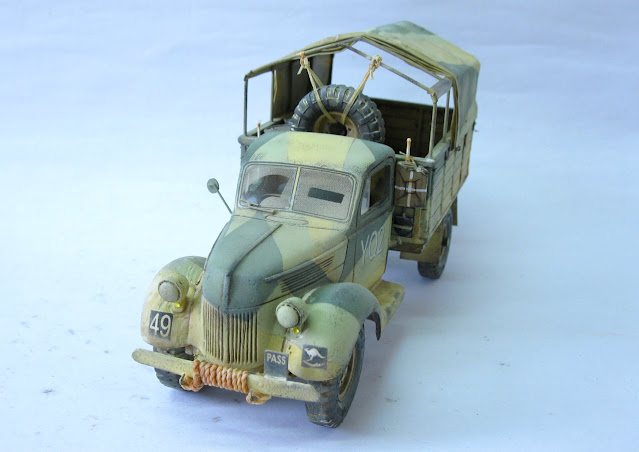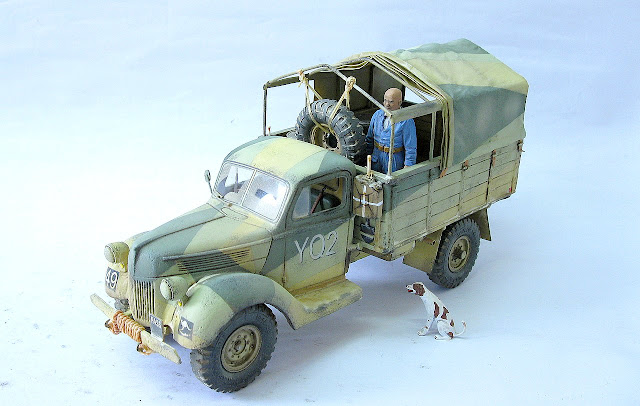Drivers!!!
Let's get to know about an old project of a resin kit practically handcrafted by an old Brazilian manufacturer, now extinct, which represents a Ford 1,5 ton. 4x2 MCP 1941 truck of Australian Army. The all history is based in this picture:
 |
| A Ford 3 ton. 4x2 MCP 30-CWT GS with .303 MG Motley mount with the crew watching for enemy planes. Australian Imperial Forces - 6th Division withdrawal from Greece - 12, April - 1941 |
The advent of WWII put Canada firmly on the map as a major supplier of Military Vehicles of many types. Up until September 1.1945, no fewer than 857.970 vehicles were produced, roughly broken down as follows:
- 4x2 Commercial and Modified Conventional Pattern (MCP): 388.299 (more than half of which were 1,5ton 4x2 MCPs)
- 4x2, 4x4, 6x4 and 6x6 Canadian Military Pattern (CMP): 390.273 (including 209.004 3-ton 4x4)
- Armoured Vehicles, wheeled and tracked: 50.241 (including 33.992 tracked carriers) plus 9.494 rear-engined chassis for India.
- Trailers, Canadian Military Pattern: 19.663.
 |
| Canadian built Ford 4x2 01T MCP 1941 1,5 ton. Notice the tires 10.50 x 16 and GS 30CWT metal cargo bed |
The Canadians themselves used 'foreign' vehicles as well, e.g. Jeeps and Diamond Ts from the USA, Bedfords and Leylands from Britain. Motorcycles were all of British and US origin (Matchless, Norton, HD). Many of the Canadian vehicles eventually served with other United Nations member countries, particularly in the late 1940s and throughout the '50s. Surplus vehicles invariably found their way to civilian operators, all over the world, and a fair number have now been restored for preservation.
 |
| A new life for the veterans... Ex Army Fords CMP 4x4 trucks in sale... Notice the prices!! Man!!! |
The so-called MCP (Modified Conventional Pattern) vehicles were contemporary civilian production types, adapted and militarized in respect of reinforced components, oversize wheels and tyres, austere detachable-top cabs, right-hand drive and other features.
 |
Ford MCP 018T - 1941 towing a 4.5inch howitzer Notice about the quasi-civil characteristics of this truck... Australia, Northern Territory - 29, Oct., 1942. 41st Australian Field Battery 11th Australian Field Regiment |
An interesting feature of the Canadian Military Pattern (CMP) vehicles was their combination of British design requirements and North American automotive engineering. Initially this compromise was not a great success but from 1942 when all trucks received a much revised cab (No. 13) it was quite acceptable. In Australian service (almost always with the No. 13 cab) these vehicles were known as the "Chev Blitz" or the "Ford Blitz".
 |
| Chevrolet CMP cabin pattern 13 Aussie Chev Blitz!! |
The major vehicle producers in Canada at the time were linked with the US 'Big Three': Ford, General Motors and Chrysler. Some of the manufacturing facilities were in close proximity to the US parent plants and certain parts and components were imported from there. The Canadian Chrysler (Dodge) and Ford factories were in fact just across the river south-east of Detroit. General Motors' main plant was - and still is - in Oshawa, Ontario.
 |
| American propaganda poster showing Aussies Fords tractors in the desert The 1st, 3rd and 4th trucks are 1941. The second is a 1939 model. |
The fourth manufacturer was FWD in Kitchener, Ontario. FWD chassis came from Clintonville in Wisconsin and were finished and completed or bodied in Canada. FWD was also engaged in the boxing of other Military Vehicles for shipment overseas. Chrysler Canada had the additional task of fitting out mobile workshops.
 |
| A strange coincidence ... A Ford CMP 15-CWT american (see USAAF in the door) alongside a Ford MPC indian pattern (RAF - British), sharing the same fate in North Africa Notice the star in the roof of the CMP cabin and the RAF roundels in the MCP front nose. 1942-43 (?) |
 |
| A Ford MCP soft cabin from RAF Notice the 10.50x16 runflat tyres, like LRDG Chevys... Malta, March, 1943. |
 |
| British Ford MCP 4x2 Truck RAF from 55th RAF Squadron transporting Aussies RAAF airmen crew. July, 1942 - Egipt - Suez Canal - Ismailia |
 |
| Aussie Ford 4x2 MCP 1941 truck with three tonne Ausssie cammo |
Numerous other firms across the nation produced trailers and bodywork of countless types and variants. Bombardier and Farand & Delorme contributed tracked machines and the Tank Arsenal at the Montreal Locomotive Works in Quebec built tanks (Valentine, Ram, Grizzly) and SP gun carriages (Sexton).
 |
| Valentine Mk I Infantry tank |
 |
| Ram Cruiser tank Mk.II |
 |
| Grizzly cruiser tank |
 |
| Sexton 25pdr. SPG |
Specifically in Australia, during the WWII, the Australian armed forces employed an astonishingly large variety of vehicles. Most were part-manufactured, i.e. built on imported (mostly Canadian) chassis.
 |
| Ford 30-CWT GS 4x2 MCP 1941 1,5 ton. truck Australian Army - Singapore Harbour - 1941 Come on, Aussies ... Push!! |
Others came from the USA under Lend-Lease or were brought back by units returning from the Middle East, or from other sources, e.g. diverted shipments. Some part-manufactured (Australian Pattern) vehicles and converted types were supplied to US forces in the South-West Pacific (reverse Lend-Lease) and also, later, to Netherlands forces and the British Pacific Fleet.
 |
| Aussie Ford MCP 3 ton "BENNIE" built as mobile cinema no.76, stuck in a ditch, to the amusement of its driver ... Australian Army Amenites Service Port Moresby - Papua, New Guinea - 1942. |
 |
| Two shots of the same Aussie soldier and truck Private (Pte) Donald Cooper beside a Ford truck with a sign AAOC Road Patrol 9th Australian Division - Libya, Tobruk - 1941 Australian Army Ordnance Corps (AAOC). The Corps gained its Royal prefix (RAAOC) for its work during the WWII. |
 |
| A brand new Ford MCP 1,5 ton workshop no.2 The same vehicle above Ford Motor Works - Australia -Victoria, Geelong.- 1941 |
Several types of Armored Fight Vehicles were made, of which UK-pattern tracked carriers were the most numerous. Of great interest was Australia's own Cruiser tank, known as the Sentinel, several of which have survived.
 |
| AC1 Sentinel cruiser tank |
Many of the wartime vehicles, particularly Australian and American tactical types, were retained for service use after 1945. As suitable new types became available the ranks of the 'wartime Jobs' were thinned accordingly, although certain types - particularly 6x6 Studebakers - were not demobbed until the 1970s.
 |
| Australian Women's Army Service personnel with a long, long line of Studebakers 6x6 trucks |
A surprising number of historical military vehicles have been preserved, primarily in the military museums at Puckapunyal and Bandiana, both in Victoria, and the Australian War Museum in Canberra, as well as various smaller museums and private collections and all the time more relics are being discovered and rescued for preservation.
 |
| Preserved Ford Marmon-Herrington LP3A Artillery 4x4 tractor 1941 Australian War Memorial |
Specs:
| Ford 30cwt GS 4x2 MCP 1941 1,5 ton. | |
|---|---|
| Production | 1940-1941 |
| Model years | 1940-41 |
| Assembly Number built | Ford Australia - Victoria, Geelong see text |
| Body and chassis | |
| Class | 1,5 ton. rated medium truck |
| Body style | 2-door civil cabin, flatbed, stake |
| Layout | Modified Commercial Patern (MCP) |
| Specifications | |
| Lenght Widht Height (cabine) Weight Engine | 6.125mm 2.310mm (cargo bed) 2.275mm 3.200 Kg Ford V8-3,9 liter 95 HP - gasoline |
| Transmission Suspension Tires | manual - 4 fwd +1rvs Front: half spring Rear: half spring+ aux. 10.50 x 20 |
| Wheelbase Brakes Fuel tank Operational range Max. Speed | 158 in (4.013 mm) oil hydraulic vaccum-assisted (all wheels) 110 liters 500 Km 85 Km/h |
 |
| Panzer Resin Models kit (#35012) In a galaxy, far far away...(2006) |
 |
| Ford MCP 4x2 30-CWT 1,5 ton. 1941 The vehicle features a Motley-type .303 anti-aircraft machine gun station |
 |
| The PRM resin kit, with details with cooper wire and the tarp made with tracing-paper... Left side |
 |
| Ford MCP from Panzer Resin Model. Right side |
 |
| Ford resin kit - rear view |
 |
| Matilda Mk II - Bovington Museum The bluish Caunter escheme is very intense ... |
 |
| "Bluish Caunter scheme"... Sorry...early days... |
 |
| In addition to the strange colors (blue arrows), some mistakes were made in the kit, such as the fuel intake on the wrong side and the right headlight misaligned (it looks like an anti-aircraft searchlight ...) Notice the red arrows .... |
 |
| The colors have been improved ... but still in 2006. |
 |
| The kit with decals and spare wheel in the frame. Notice that this photo was used as box art by PRM |
 |
| A very, very good stuff for any modeler who likes British WWII weaponry |
 |
| Caunter scheme colors... |
 |
| Caunter Scheme colors in the Aussie Ford truck... |
 |
| Oh, man... This is embarrassing. Watch your words, Ms. AK !!! |
 |
| Do you remember the anti-aircraft headlights? I took the opportunity and corrected that defect. Now the headlights are in the correct parallelism ... Also notice the two tow hooks that I installed in the front bumper. |
 |
| After washing and dry-brush... Notice the spare wheel tied to the canvas frame ... |
 |
| Notice on the two shovels installed just behind the cabin ... An essential tool in dry and difficult terrain, like in the Greek hills. |
 |
| Another essential item in a dry terrain: a jerry-can with water, a gift from the Krauts... |
 |
| Left side view... |
 |
| Spare wheel close up, fuel drums in the cargo bed and the shovels... |
 |
| Did you notice Lee Enfield .303 inside the cabin, leaning on the seat? |
 |
| Chipping and weathering with sand pigments... The windshields are waiting for a sandstorm ... |
 |
| Notice the rope, tied to the front hooks and wrapped around the bumper ... |
 |
| Notice the tail lights in red... |
 |
| Almost ready... |
 |
Ford MCP 30-CWT GS 4x2 1,5 ton. truck. Australian Imperial Forces - 6th Division, Headquarters Greece - April, 1941. |
 |
| Ford MCP 30-CWT GS 4x2 1,5 ton. truck |
 |
| Ford MCP 30-CWT GS 4x2 1,5 ton. truck - left side |
 |
| Ford MCP 30-CWT GS 4x2 1,5 ton. truck - right side |
 |
| Ford MCP 30-CWT GS 4x2 1,5 ton. truck with Kojak and Rover, the dog. |
 |
| Kojak couldn't resist testing the new vehicle ... |
 |
| Ford MCP 30-CWT GS 4x2 1,5 ton. truck and Dodge MCP T110 3 ton truck... two civilian girls in military wearings... |
 |
Ford MCP 30-CWT GS 4x2 1,5 ton. truck. Australian Imperial Forces - 6th Division, Headquarters Greece - April, 1941. |














